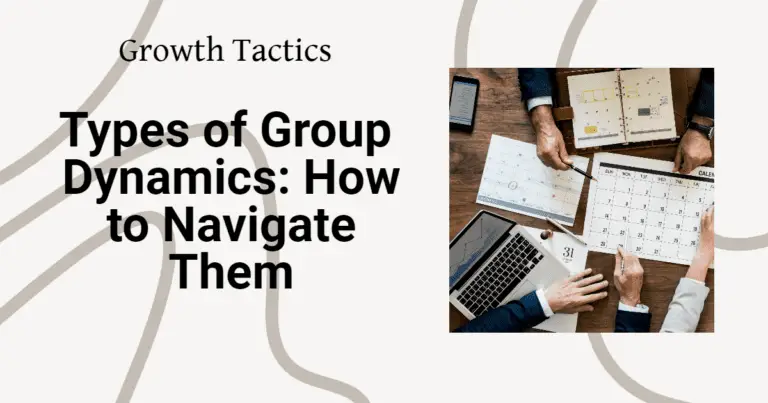Today we’ll explore the different types of group dynamics and learn how to navigate them like a pro. Whether you’re part of a team at work, a student group, or even a casual social gathering, understanding group dynamics can make all the difference in achieving our common goals and fostering harmonious interactions.
Jump To Section
Understanding Group Dynamics
Let’s kick off our journey into the fascinating realm of group dynamics by understanding what it’s all about. So, what exactly do we mean by “group dynamics”?
Group dynamics refers to the patterns and interactions that occur within a group. It’s like a dance of thoughts, emotions, and behaviors that shape how a group functions and achieves its goals. It’s all about how group members interact with one another, the roles they play, and the relationships they develop.
Now, you might be thinking, “But why is understanding group dynamics important?” Well, my friend, when we have a clear understanding of group dynamics, we’re equipped with the knowledge and insights to navigate them effectively. It helps us foster collaboration, build strong relationships, and optimize group performance.
At its core, group dynamics is all about how people come together and create something greater than themselves. Whether it’s a project team, a sports team, or a social group, each group has its own unique dynamics. By delving into the study of group dynamics, we can uncover the underlying forces that shape group behavior and leverage them to create positive outcomes.
Now that we have a solid grasp of what group dynamics entails, let’s dive deeper into the different types of group dynamics that exist. Buckle up, my friend, because we’re about to unravel the mysteries and unveil the secrets of successful group dynamics!
Keep reading as we explore the various types of groups, from formal to informal, and learn how they influence group dynamics. Exciting times lie ahead, so let’s continue our journey together!

Different Types of Group Dynamics
It’s time to set sail on a voyage through the enchanting realm of group dynamics. Here, we’ll navigate the treacherous waters of different group types and uncover the secrets to harnessing their unique dynamics. So, grab your compass and telescope as we embark on this thrilling expedition.
Formal Groups: A Structured Voyage
These are crews with a designated purpose and structure. They often include professional associations, committees, or project teams. Here, the ship’s course is charted clearly, with predefined goals and roles assigned to each member. The group adheres to specific rules, protocols, and hierarchies. As the group navigator, it’s essential to establish open communication channels, clarify expectations, and ensure everyone is on board with the shared mission.
Informal Groups: Discovering Hidden Treasures
These are like ships that come together naturally, driven by social connections and affiliations. Think of your lunch buddies at work or your friends from a hobby club. While these groups may not have a formal structure, they are bound by shared interests, personal relationships, and a sense of camaraderie. As the expert navigator, you must foster a supportive and inclusive environment, encouraging open dialogue, and leveraging the strengths and diversity within the group.
Temporary Groups: Sailing on a Transient Path
These are crews assembled for a specific purpose or task and exist only for a limited time. Think of teams formed to plan an event or tackle a one-time project. These groups require intense collaboration and a speedy formation of bonds. As the skilled navigator, your expertise lies in initiating group cohesion swiftly, establishing clear objectives, and facilitating effective communication to ensure smooth sailing within the limited timeframe.
Virtual Groups: Navigating Digital Waters
Here, the ship sails through the vast ocean of technology and digital spaces. These groups rely on electronic communication platforms, such as video conferences or online forums, to connect individuals located at different physical locations. The art of navigating virtual groups lies in leveraging virtual tools effectively, setting clear guidelines for communication and participation, and fostering a sense of belonging despite the physical distance. As the trusted expert, you help your group master the art of virtual collaboration, making the most of the digital waves.
Interdisciplinary Groups: Exploring New Horizons
These are crews with diverse backgrounds, expertise, and perspectives. They bring together individuals from various disciplines to tackle complex challenges. Think of a team of professionals from different fields working on a research project. Navigating interdisciplinary groups involves embracing the richness of diverse perspectives, fostering open-mindedness, and facilitating effective communication across disciplines. As the seasoned navigator, you encourage collaboration and bridge the gaps, allowing the group to explore uncharted territories.
Trust me, my friend, understanding the different group dynamics is the key to successful navigation. By unraveling the characteristics and nuances of each type, you’ll be prepared to lead your crew through any challenge they may face.

Stages of Group Development
When a group comes together, they go through a series of stages that shape their dynamics and progress. Understanding these stages can help us navigate the journey more smoothly. So, without further ado, let’s explore the stages of group development!
Forming
Ah, the beginning of a beautiful journey! In the forming stage, group members are getting acquainted with one another, defining their roles, and establishing an initial sense of trust and purpose. Picture it like the first day of a new job or the first meeting of a project team.
During the forming stage, individuals may feel excited yet a little apprehensive about the group’s objectives and how they fit into the bigger picture. It’s a time of exploration, where everyone is trying to figure out their place in the group and what they bring to the table. Communication tends to be more polite and formal, as people navigate the waters and build initial connections.
Storming
Ah, buckle up! We’ve entered the storming stage, the phase where the group dynamics might hit a bumpy road. As group members become more comfortable with one another, differences in opinions, perspectives, and ways of working can surface.
The storming stage is characterized by debates, disagreements, and power struggles within the group. People may challenge established norms, question authority, and find their voices amidst the chaos. It’s like a thunderstorm clearing the air, allowing the group to address conflicts and work through challenges.
As a group navigates the storming stage, it’s essential to foster open communication, active listening, and a non-judgmental atmosphere. Embracing these crucial aspects can help the group successfully overcome conflict and move towards the next stage.
Norming
Ahh, we’ve made it through the storm, and the sun is starting to shine! Welcome to the norming stage, where the group begins to find common ground, establish shared values, and develop a sense of cohesion.
During the norming stage, group members start to embrace their individual strengths and understand how they can contribute to the group’s collective goals. Roles and responsibilities become clearer, and trust and camaraderie among members deepen. It’s like finding your groove on a dance floor, where everyone is tuned in to the rhythm and moving together harmoniously.
This stage is marked by increased collaboration, respect, and mutual support. The group sets norms and expectations, creating a positive environment that promotes productivity and effective teamwork.
Performing
Woohoo, it’s showtime! We’ve reached the performing stage – the sweet spot where the group hits high gear and works together seamlessly towards achieving their objectives.
In the performing stage, the group is firing on all cylinders. There’s a clear understanding of goals, effective communication flows effortlessly, and trust and synergy are at their peak. It’s like a well-rehearsed orchestra delivering a flawless performance.
Group members in the performing stage have a shared vision and trust in their collective abilities. They leverage their diverse perspectives and strengths to tackle challenges and achieve outstanding results. The focus is on continuous improvement, innovation, and success.
Navigating these stages of group development takes skill, patience, and a deep understanding of group dynamics. By recognizing and embracing the unique characteristics of each stage, we can guide our groups towards mutual growth and success.
So, there you have it – the stages of group development: forming, storming, norming, and performing. Armed with this knowledge, you’re now equipped to guide your groups through their journey, fostering cooperation, and achieving greatness together. Keep these stages in mind as we move forward in our exploration of group dynamics!

Navigating the Different Roles of Members of the Group
Ah, my curious explorer, let’s embark on a voyage to uncover the fascinating world of the various roles within groups. Just like a symphony orchestra, where each instrument plays a unique part, group dynamics thrive when different roles harmonize to create a masterpiece. So, my friend, let’s set the stage and explore the diverse cast of characters within a group structure.
Leader: Guiding the Ship
Ah, the leader, the captain of the ship, steering the group towards success with a steady hand and clear vision. The leader sets the direction, clarifies goals, and inspires the team to reach new heights. With their experience and expertise, they guide the group, making crucial decisions, facilitating communication, and providing support when needed. The leader’s presence brings stability and unity, ensuring the group stays on course.
Facilitator: Orchestrating Collaboration
Ah, the facilitator, the conductor of the group’s symphony. This role focuses on creating a supportive and inclusive environment, encouraging participation and collaboration. A skilled facilitator guides discussions, ensures equitable contributions, and helps to navigate through conflicts constructively. Their ability to listen actively, ask thought-provoking questions, and manage group dynamics allows the ensemble to achieve a harmonious balance.
Organizer: Keeping Things Shipshape
Ah, the organizer, the logistics maestro of the group. This role thrives in ensuring that everything runs smoothly, managing schedules, resources, and tasks. They keep track of deadlines, coordinate meetings, and ensure everyone has what they need to contribute effectively. With their attention to detail and organizational prowess, the group can sail through projects efficiently, avoiding any rocky shores.
Idea Generator: Sparking Creativity
Ah, the idea generator, the creative spark that ignites the group’s imagination. This role excels in coming up with fresh ideas, thinking outside the box, and challenging the status quo. Their passion for innovation and ability to inspire others injects a burst of energy into the group. The idea generator fuels the group’s creativity, pushing boundaries and opening new doors of possibility.
Mediator: Navigating Stormy Waters
Ah, the mediator, the peacemaker within the group. This role thrives in resolving conflicts, smoothing rough waters, and fostering positive relationships. With their exceptional communication skills and empathetic nature, they help the group navigate through differences and find common ground. The mediator ensures that everyone’s voice is heard and works towards finding win-win solutions that benefit the entire ensemble.
Contributor: Playing Their Part
Ah, the contributors, the individual instrumentalists who bring their unique talents and expertise to the group. Each member plays a vital role in fulfilling the group’s objectives. From sharing ideas, offering insights, taking on specific tasks, or providing support, their contributions create a rich tapestry of collaboration and success. The cohesive efforts of the group bolstered by the contributors’ dedication lead to remarkable achievements.
Embracing and Balancing Roles
Ah, the beauty of group dynamics lies in the interplay and balance of these different roles. It’s essential to recognize and appreciate the various strengths and contributions of each member within the group. Embrace the diversity of roles and allow individuals to shine in their respective areas of expertise. Foster open communication, encourage collaboration, and value each person’s unique contributions.
Remember, my fellow explorer, that these roles are not fixed positions. Rather, they are fluid and may shift depending on the needs of the group and the task at hand. Embrace the flexibility and adaptability of roles within your group, allowing each member to contribute their strengths and talents as the journey unfolds.
So, my friend, set sail on your group’s adventure, valuing and harnessing the power of each role. With a well-balanced ensemble, your group will navigate the vast ocean of possibilities, creating harmonious melodies of achievement and fulfillment.

Navigating Group Dynamics
Now that we’re well-versed in the different types of groups and the stages of group development, let’s take a deeper dive into how we can navigate the complex waters of group dynamics. Buckle up, as we explore some essential aspects of effective group navigation.
Effective Communication: The Key to Success
Communication, ah, what a beautiful thing! It’s the lifeblood of any successful group. Effective communication is like a powerful language that enables ideas to flow, fosters understanding, and encourages collaboration.
To navigate group dynamics, it’s crucial to establish clear channels of communication and encourage open and honest dialogue. Active listening plays a key role here – truly hearing and understanding what others are saying, and responding thoughtfully. This fosters a culture of respect, encourages diverse perspectives, and ensures that crucial information is shared and understood. Remember, great communication isn’t just about talking, but also about listening and creating a safe space for everyone to contribute.
Resolving Conflict: Smooth Sailing Ahead
Ah, conflict, the inevitable storm that can rock the boat of any group. But fear not, for conflict can also be an opportunity for growth and understanding. When handled effectively, conflict can lead to better decision-making, more robust ideas, and stronger relationships.
When conflicts arise, it’s vital to address them in a timely and constructive manner. Encourage open and respectful discussion, where everyone involved has an opportunity to express their perspectives and concerns. Facilitate compromise and find common ground, seeking win-win solutions that benefit everyone.
Remember, as a navigator of group dynamics, your role is to guide the group towards effective conflict resolution, promoting a healthy and positive team culture.
Building Trust: The Glue that Holds Us Together
Trust, oh sweet trust, the foundation upon which successful groups are built. Trust is like the glue that holds individuals together, allowing them to work cohesively towards shared goals. Without trust, group dynamics can become strained and progress can be hindered.
Building trust within a group requires consistency, reliability, and transparency. Be sure to foster an environment where individuals feel safe to be vulnerable, take risks, and express their thoughts and ideas without fear of judgment or ill-treatment. Trust is built through good intentions, accountability, and follow-through.
As a group navigator, it’s crucial to model trustworthiness and encourage trust-building activities, such as team-building exercises, sharing personal stories, and recognizing and appreciating individual contributions.
Managing Group Roles: Balancing the Ship
Ah, the roles within a group, like pieces of a puzzle that fit together harmoniously. Effectively managing group roles ensures that responsibilities are distributed evenly, tasks are carried out efficiently, and everyone feels valued and utilized.
Navigating group roles involves identifying individual strengths, assigning tasks that align with those strengths, and providing opportunities for growth and development. Encourage collaboration, where members can support and learn from one another, filling in gaps to create a well-rounded team.
Remember, flexibility is key. Roles may need to be adapted and adjusted as the group evolves and new challenges arise. As a group navigator, keep an eye on the distribution of work, ensure that everyone has a chance to contribute, and step in when necessary to keep the ship sailing smoothly.
By focusing on effective communication, resolving conflict in a constructive manner, building trust, and managing group roles, you’ll be sailing through the complex world of group dynamics like a seasoned captain. These skills will help you create an environment that fosters collaboration, drives success, and nurtures meaningful connections within your group.
Group Cohesiveness: Building Strong Bonds and Team Spirit
Ah, group cohesiveness, the magic ingredient that transforms a collection of individuals into a closely-knit team. It’s like the secret sauce that brings out the best in groups, fostering collaboration, trust, and shared purpose. So, my dear reader, let’s dive into the fascinating world of group cohesiveness and discover how it can elevate your team to new heights!
The Power of Togetherness
Picture a group that clicks like a well-oiled machine, where members support and rely on one another, not just as colleagues, but as friends. That, my friend, is the power of group cohesiveness. When a team is cohesive, everyone feels a sense of belonging and camaraderie. They share a deep bond, working towards a common goal with enthusiasm and commitment.
Nurturing Trust and Collaboration
Trust, oh sweet trust, the foundation of strong group cohesiveness. It’s about creating an environment where individuals feel safe to be themselves, take risks, and speak their minds without fear of judgment or rejection. Trust allows team members to build open and honest relationships, relying on one another’s strengths and supporting each other through challenges.
A cohesive group cultivates a culture of collaboration, where everyone actively listens, respects different perspectives, and seeks input from others. The beauty of collaboration lies in the ability to tap into the collective wisdom of the team, resulting in richer ideas, better decision-making, and innovative solutions.
Shared Goals and Purpose
A group without a shared purpose is like a ship without a destination. Cohesive teams align their goals and values, creating a sense of direction and purpose that drives their collective efforts. When everyone understands and believes in the team’s mission, they become motivated and energized to go the extra mile.
To foster group cohesiveness, it’s essential to ensure that everyone’s voice is heard and that individual contributions are acknowledged and valued. Encourage open discussions about goals and how to achieve them, allowing team members to have a say in the decision-making process. This not only strengthens the bond between team members but also increases their commitment to the team’s objectives.
Cultivating a Positive Group Culture
Ah, the culture of a cohesive group, like the air we breathe – invisible but ever-present. A positive group culture is created when everyone feels respected, celebrated for their unique contributions, and comfortable expressing their thoughts and concerns.
As a group leader or member, it’s crucial to foster an environment where positivity thrives. Encourage teamwork, celebrate achievements, and provide constructive feedback to help individuals grow. Take the time to connect on a personal level, nurturing relationships beyond the confines of work. These small acts of kindness and support contribute to a vibrant and cohesive team culture.
Experience the Power of Cohesiveness
Ah, the wonders of group cohesiveness! It turns ordinary teams into extraordinary ones, where individuals become more than the sum of their parts. Experience the power of togetherness, trust, collaboration, and shared purpose within your own group.
In Conclusion
By nurturing trust, promoting collaboration, aligning goals, and cultivating a positive group culture, you’ll witness the transformation of your team into a cohesive powerhouse. Embrace the magic of group cohesiveness, my friend, and watch as your team soars to new heights of success and fulfillment.


